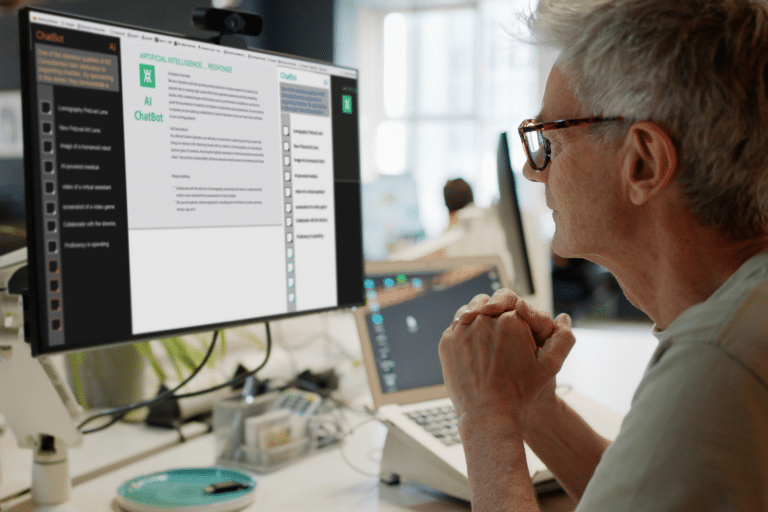Introduction: The AI Shift Is Here—And Employees Are Feeling It
The workplace is facing a seismic shift. Artificial intelligence is no longer just a future consideration—it’s here, and it’s already transforming how we work. From customer service to data analysis, AI is automating tasks, accelerating processes, and—understandably—raising big questions for employees.
The conversations happening in leadership circles often focus on productivity gains and cost savings. But in the employee break room (or Slack thread), a different conversation is happening: Will AI replace me? Will I still have a job in six months? Will my skills be obsolete?
This tension creates a dangerous storm for organizations. Left unaddressed, it can erode trust, create disengagement, and drive your top talent out the door.
Leaders need to understand the connection between AI and employee engagement—and act fast. By calming fears, improving communication, and reinforcing the value of human work, companies can navigate change without losing their people in the process.
1. Understand the Nature of AI-Driven Fear
Let’s be clear: fear of AI isn’t irrational. The news is filled with layoffs related to automation, new tools that replace entire departments, and projections that entire industries could shrink or disappear.
But for most employees, the core fear isn’t just being replaced—it’s being irrelevant. People worry they’ll lose not only their job but their purpose, identity, and influence.
This emotional component is why blanket statements like “AI will help us all work better!” often fall flat. Leaders must engage with the very human side of the transition.
Action Tip:
Start by acknowledging the fear directly. In all-hands meetings or manager 1:1s, say:
“We know there’s uncertainty about how AI will affect your roles. We’re committed to keeping you informed, supporting your growth, and making sure you’re part of the solution.”
By leading with empathy, you can begin building trust—which is the foundation of engagement.

2. Disengagement Is the Symptom. Sentiment Is the Cause.
If employees feel anxious, left out of the loop, or undervalued, they’ll show it—not always in words, but in behavior.
Signs of disengagement:
Lower output or missed deadlines
Reduced collaboration or participation
More “checked out” behavior in meetings
Increased absenteeism or quiet quitting
These aren’t performance problems—they’re culture signals.
This is where data becomes your best ally. Employee engagement surveys can help you track how your team is reacting to change, including AI integration. They allow you to move beyond assumptions and gather hard evidence about how people are really feeling.
Action Tip:
Include AI-specific questions in your surveys, such as:
I understand how AI will impact my role at this company.
I feel confident the company will invest in my growth alongside new technologies.
I trust leadership to communicate transparently about the future of work here.
Then, act on what you learn. Engagement doesn’t improve just because you asked—it improves because you responded.
3. Create Psychological Safety Through Two-Way Communication
Communication is a two-way street. When employees feel like they can’t ask questions or express concerns, anxiety festers.
One of the best ways to combat fear is to give it voice. Leaders who open channels for dialogue—even difficult dialogue—signal that they value employee input and aren’t afraid of hard conversations.
Action Tip:
Host monthly “AI and the Future of Work” sessions or internal AMAs (Ask Me Anything) where executives respond to anonymous employee questions.
Have managers include “tech change check-ins” in 1:1s where employees can talk about how new tools are impacting their work.
Use pulse surveys to identify communication breakdowns or areas where fear is highest.
This helps shift your culture from one of rumor to one of reality—and from fear to shared focus.

4. Reskill, Upskill, and Reinforce Employee Value
The companies best positioned to benefit from AI aren’t the ones automating the fastest—they’re the ones investing in their people. Why? Because AI adoption without human adaptability creates friction, resistance, and eventual failure.
Leaders must send a clear message: we’re not replacing people—we’re evolving roles. That means actively investing in reskilling, upskilling, and career pathing for employees across all levels.
Action Tip:
Create an “AI-readiness” learning program tailored to different functions.
Offer internal certificates or badges for completing new tech training.
Spotlight internal success stories of employees who have grown with AI, rather than being replaced by it.
This builds confidence, strengthens loyalty, and increases employee engagement during change.
5. Make Culture Your Competitive Advantage
When faced with rapid change, companies with a strong culture of trust, transparency, and adaptability are more resilient. Your engagement strategy shouldn’t just be reactive—it should be proactive.
Employees who feel heard, valued, and included are far more likely to weather uncertainty with optimism. Those who don’t? They’ll disengage—or leave.
Action Tip:
Build an ongoing rhythm of listening and action:
Pair engagement surveys with quarterly stay interviews to get qualitative and quantitative insights.
Involve employees in shaping AI policies or implementation timelines.
Regularly share updates—even if the update is “we’re still evaluating.” Silence breeds fear. Transparency builds confidence.

Conclusion: Lead Through the Storm
Artificial intelligence isn’t just changing workflows—it’s changing how people feel about their place in the workplace. For leaders, this is both a risk and an opportunity.
When you prioritize AI and employee engagement—listening to your people, addressing fear head-on, and making them part of the change—you build a culture that can weather any storm. The future of work is uncertain, but your response doesn’t have to be.
Calm the storm. Build the bridge. Lead with empathy, and your people will follow—even through the AI hurricane.
Want an Employee Survey Partner?
As expectations grow and the workforce becomes more dynamic, HR leaders need modern tools to stay ahead. The role of employee survey providers has never been more critical—or more exciting.

If you’re looking for a partner who offers flexibility, intelligence, and a truly people-first approach, it’s time to see what People Element can do. We’re more than a survey platform—we’re your partner in building a more connected, engaged, and resilient workforce.
Ready to level up your engagement strategy? See People Element in action with a virtual product tour.




